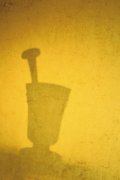 We live in an age of chemophobia, an insidious disease that threatens our way of life, precludes R & D that might solve many of the environmental issues we face and prevents disease-stopping compounds being deployed where they are most needed in the developing world. Chemophobia is an irrational fear of all things chemical and is usually contracted by those already with naturophilia, the irrational love of all things natural.
We live in an age of chemophobia, an insidious disease that threatens our way of life, precludes R & D that might solve many of the environmental issues we face and prevents disease-stopping compounds being deployed where they are most needed in the developing world. Chemophobia is an irrational fear of all things chemical and is usually contracted by those already with naturophilia, the irrational love of all things natural.
It usually starts with a dose of nostalgia, pangs for a time when the world was simpler, and an aching for a natural world that we have long since lost. Unfortunately for sufferers, there never was a time of simplicity and natural living. In those halcyon days of yore, infectious disease was rife, infant mortality rates were high, and life expectancy was very low.
Natural, at that time meant, inept remedies for lethal diseases such as polio, tuberculosis, bacterial infections, and plague. It meant poor harvests and widespread famine, and if disease didn’t catch you young, only those who kept their heads very low were safe from interminable wars, rock-breaking on distant sun-bleached shores, or the hangman’s noose, guilty or otherwise. Today, we may have more obesity and diabetes and certainly fare more incidences of the diseases of old age, but that’s because we have more food to eat (in the developed world, at least) and live longer.
Certainly, natural does not equate to good for you – think snake venom, belladonna, and deadly toadstools, whereas most synthetic chemicals have a strong pedigree and have tested safety and toxicity. But throw in the fact that most chemophobics also have risk assessment blindness as well as dystatistica and we see pronouncements on all things chemical and synthetic as being bad.
It is from this, that the UNEP Dirty Dozen Chemicals list emerges. Not only has it a far too conveniently tabloid name to be believed, but several of the entries are not single chemicals but whole families.
Needless to say, several of these, while appearing to be the harbinger’s of doom media hyperbole would have us believe, are not necessarily as dangerous to us or the environment as you might think, and others, such as DDT could be used to help eradicate one of the biggest global killers. Indeed, the WHO now allows for the use of DDT to fight malaria-bearing mosquitoes.
-
Aldrin (pesticide)
-
Chlordane (pesticide)
-
DDT (pesticide, highly effective against malaria-carrying mosquitoes)
-
Dieldrin
-
Heptachlor
-
Mirex
-
Toxaphene
-
Polychlorinated biphenyls (PCBs, a whole group of diverse compounds, each with
its own properties)
-
Hexachlorobenzene
-
Dioxins (a whole diverse group of compounds)
-
Furans (a whole diverse group of compounds, each with its own properties)
These compounds are now banned under UNEP, but were not used in manufacturing before this list was created.
There are other lists, such as the List of RoHO prohibited substances, which includes lead, cadmium, mercury, hexavalent chromium, polybrominated biphenyl (PBB) polybrominated diphenyl ether (PBDE) flame retardants, which is fair enough. And, industry-specific lists, such as the Volvo manufacturing black list, which lists all the compounds that may not be used in its production lines, including CFC cooling agents, the paint hardener methylenedianiline, and the previously discussed carbon tetrachloride
In a forthcoming issue of the International Journal of Sustainable Manufacturing (2008, 1, 41-57), Jack Jeswiet, of the Department of Mechanical Engineering, at Queen’s University, Kingston, Ontario, Canada and Michael Hauschild of the Danish Technical University, Denmark, argue the case that market forces need to inform environmental design. One can only assume that this should be one of the drivers rather than media scare stories, chemophobia and the simplistic blanket precautions of lists.
Greenhouse gas emissions, environmental impact, and toxic substances to be avoided must all be addressed by the EcoDesigner in any design situation, they say. The ecodesigner cannot control market forces, but must aware of them and rules should be followed to reduce the eco footprint.
At the time of writing, a news release from the UK’s Royal Society’s summer science exhibition presented findings from consumers tests being carried out during the event which is open to the public. The researchers involved, from the National Physical Laboratory, are working towards producing the world’s first model that will predict how we perceive “naturalness”. They claim that the results could help manufacturers produce synthetic products that are so good they seem “natural” to our senses and are fully equivalent to the “real thing”, but with the benefits of reduced environmental impact and increased durability.
Meanwhile, a new study shows that companies are significantly hijacking the language of environmentalists to their own marketing ends, presumably hoping to leverage the best out of the movement in selling their products.
 Remote arsenic assessment – A topic I’ve come back to again and again since I first covered for The Guardian the breaking news of arsenic contaminated tubewells on the Indian sub-continent in 1995. Now, an informatics approach to surface data could allow geologists and environmental scientists to identify regions of the world where people are at risk of exposure to arsenic in their drinking water without the need for widespread sampling to be undertaken. More…
Remote arsenic assessment – A topic I’ve come back to again and again since I first covered for The Guardian the breaking news of arsenic contaminated tubewells on the Indian sub-continent in 1995. Now, an informatics approach to surface data could allow geologists and environmental scientists to identify regions of the world where people are at risk of exposure to arsenic in their drinking water without the need for widespread sampling to be undertaken. More… We live in an age of chemophobia, an insidious disease that threatens our way of life, precludes R & D that might solve many of the environmental issues we face and prevents disease-stopping compounds being deployed where they are most needed in the developing world. Chemophobia is an irrational fear of all things chemical and is usually contracted by those already with naturophilia, the irrational love of all things natural.
We live in an age of chemophobia, an insidious disease that threatens our way of life, precludes R & D that might solve many of the environmental issues we face and prevents disease-stopping compounds being deployed where they are most needed in the developing world. Chemophobia is an irrational fear of all things chemical and is usually contracted by those already with naturophilia, the irrational love of all things natural. I’ve got some wide-ranging research to report in this week’s SpectroscopyNOW, including mineral tests, colour MRI, the Agent Smith of prions, and a new approach to spotting doped athletes.
I’ve got some wide-ranging research to report in this week’s SpectroscopyNOW, including mineral tests, colour MRI, the Agent Smith of prions, and a new approach to spotting doped athletes.
 First online in The Alchemist, this week, is an award for pioneering work in mass spectrometry and the study of molecules colliding with surfaces.
First online in The Alchemist, this week, is an award for pioneering work in mass spectrometry and the study of molecules colliding with surfaces. Reminiscences on a serious Stateside gun crime: You would think you wouldn’t find a less controversial topic to write about than the analysis of heavy metals using thermal ionisation mass spectrometry (TIMS). In some ways it must sound like the dullest topic in the world, beyond those who work with MS. However, when the metal in question is lead, and its source is ammunition then I should have been prepared for a flame-war from the US readership over one particular specialist publication for which I wrote on the subject a few years ago. The bottom line is: don’t make flippant remarks connecting guns and ill health unless you want to be shot down in flames.
Reminiscences on a serious Stateside gun crime: You would think you wouldn’t find a less controversial topic to write about than the analysis of heavy metals using thermal ionisation mass spectrometry (TIMS). In some ways it must sound like the dullest topic in the world, beyond those who work with MS. However, when the metal in question is lead, and its source is ammunition then I should have been prepared for a flame-war from the US readership over one particular specialist publication for which I wrote on the subject a few years ago. The bottom line is: don’t make flippant remarks connecting guns and ill health unless you want to be shot down in flames. A simpler, gentler eye test based on Raman spectroscopy could spot ocular infection and other problems without irritating patients, although they may be required to yawn during the procedure. Whichever way you look at them, whether through the emotional blur of crying or as lachrymal secretions ripe for analysis, tears are complex. Now, researchers in the UK, have taken a close look at this aqueous solution of proteins, metabolites, electrolytes and lipids using Raman spectroscopy and obtained results that would make any ocular enthusiast cry with joy. Read more about this today in a sneak preview of my SpectroscopyNOW column for June 1.
A simpler, gentler eye test based on Raman spectroscopy could spot ocular infection and other problems without irritating patients, although they may be required to yawn during the procedure. Whichever way you look at them, whether through the emotional blur of crying or as lachrymal secretions ripe for analysis, tears are complex. Now, researchers in the UK, have taken a close look at this aqueous solution of proteins, metabolites, electrolytes and lipids using Raman spectroscopy and obtained results that would make any ocular enthusiast cry with joy. Read more about this today in a sneak preview of my SpectroscopyNOW column for June 1. More popular science news with a spectroscopic bent from the desk of David Bradley, this week: Heavy metal and Alzheimer’s – While the protein-like plaques that form in the brains of people with Alzheimer’s disease and in other tissues in a wide range of different disorders are well known, what is less well known is that fairly high concentrations of transition metal elements, including copper, iron, and zinc, are also present. Do these metals have a role to play in plaque formation or are they a side-effect. New research using X-ray and NMR spectroscopy could shed light on the issue and perhaps one day lead to new approaches to therapy based on controlling these metals.
More popular science news with a spectroscopic bent from the desk of David Bradley, this week: Heavy metal and Alzheimer’s – While the protein-like plaques that form in the brains of people with Alzheimer’s disease and in other tissues in a wide range of different disorders are well known, what is less well known is that fairly high concentrations of transition metal elements, including copper, iron, and zinc, are also present. Do these metals have a role to play in plaque formation or are they a side-effect. New research using X-ray and NMR spectroscopy could shed light on the issue and perhaps one day lead to new approaches to therapy based on controlling these metals.